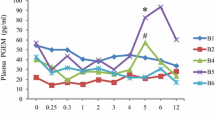Abstract
Aim: The objective of this study was to evaluate the pharmacokinetics of prostaglandin E1 (PGE1) and its metabolites after infusion of alprostadil in patients undergoing haemodialysis.
Methods: In a single-blind, randomised, 2-way crossover study including eight patients with end-stage renal disease undergoing haemodialysis, alprostadil (60µg PGE1) and placebo were administered by an intravenous infusion over 2 hours in parallel to dialysis. A specific highly sensitive analytical method was used to detect plasma levels of PGE1 and its metabolites.
Results: Endogenous plasma levels of PGE1 were approximately 1 ng/L and did not change during dialysis. Plasma concentrations of unchanged drug increased to 11 ng/L, followed by a rapid drop to baseline levels after the end of the infusion. Comparing PGE1 plasma concentrations measured in the arterial inlet and venous outlet line of the dialyser, no significant extraction of PGE1 was found, which was also reflected by measurements from dialysis fluid. Plasma concentrations of metabolites 13,14-dihydro-prostaglandin E1 (PGE0) and 15-keto-13,14-dihydro-prostaglandin E1 (15-keto-PGE0) confirm the results described for the unchanged drug, indicating that no significant extraction occurs during dialysis. The pharmacokinetic profiles of PGE1 and its metabolites in patients undergoing dialysis are similar to those previously reported for healthy volunteers, with endogenous plasma levels of about 1 ng/L (PGE1 and PGEo) and 10 ng/L (15-keto-PGE0) and maximal plasma concentrations after a 2-hour infusion of about 11, 13 and 330 ng/L (PGE1, PGE0 and 15-keto-PGE0, respectively).
Conclusions: There is no extraction of unchanged PGE1 and its metabolites during an intravenous infusion of alprostadil in parallel with haemodialysis. A dose adjustment for patients undergoing dialysis is not necessary. The pharmacokinetics of PGE1 and its metabolites are similar in patients undergoing dialysis compared with those in healthy volunteers.
Similar content being viewed by others
References
Kloeze J. Relationship between chemical structure and platelet-aggregation activity of prostaglandins. Biochem Biophys Acta 1969; 187: 285–92
Whittle BJR, Moncada S, Vane JR. Comparison of the effects of prostacyclin (PGI2), prostaglandin E1 and D2 on platelet aggregation in different species. Prostaglandins 1978; 16: 373–88
Olsson AG, Carbon LA. Clinical, haemodynamic and metabolic effects of intraarterial infusion of prostaglandin E1 in patients with peripherical arterial disease. Adv Prostaglandin Throm-boxane Res 1976; 1: 429–32
Hirai M, Nakayama R. Haemodynamic effects of intraarterial and intravenous administration of prostaglandin E1 in patients with peripherial arterial disease. Br J Surg 1986; 73: 20–3
Uekama K, Hirayama F, Ikeda K, et al. Utilization of cyclo-dextrin complexation for separation of E1, A and B prostaglandins by ion echange liquid chromatography. J Pharm Sci 1977; 66: 706–10
Habon I, Fritsch S, Szejtli J. Simulations of pharmacokinetic behaviour of drug-cyclodextrin complexes. Pharmazie 1984; 39: 830–4
Peskar B A, Cawello W, Rogatti W, et al. On the metabolism of prostaglandin E1, administered intravenously to human volunteers. J Physiol Pharmacol 1991; 42: 327–31
Cawello W, Schweer H, Müller R, et al. Metabolism and pharmacokinetics of prostaglandin E1 administered by intravenous infusion in human subjects. Eur J Clin Pharmacol 1994; 46: 275–7
Hamberg M, Samuelsson B. On the metabolism of prostaglandin E1 and E2 in man. J Biol Chem 1971; 241: 6713–21
Cawello W, Leonhardt A, Schweer H, et al. Dose proportional pharmacokinetics of alprostadil (prostaglandin E1) in healthy volunteers following intravenous infusion. Br J Clin Pharmacol 1995; 40: 273–6
Schweer H, Meese CO, Watzer B, et al. Determination of prostaglandin E1 and its main plasma metabolites 15-keto-prostaglandin E0 and prostaglandin Eo by gas chromato-graphy/negative ion chemical ionization triple stage quadrupole mass spectrometry. Biol Mass Spectrom 1994; 23: 165–70
Cawello W, editor. Parameters for compartment-free pharma- cokinetics. Aachen: Shaker Verlag, 1999
Author information
Authors and Affiliations
Corresponding author
Rights and permissions
About this article
Cite this article
Cawello, W., Kuhlmann, U., Schweer, H. et al. Pharmacokinetics of Alprostadil (Prostaglandin E1) in Patients Undergoing Haemodialysis. Clin. Drug Investig. 18, 279–285 (1999). https://doi.org/10.2165/00044011-199918040-00004
Published:
Issue Date:
DOI: https://doi.org/10.2165/00044011-199918040-00004




